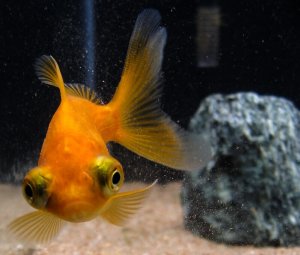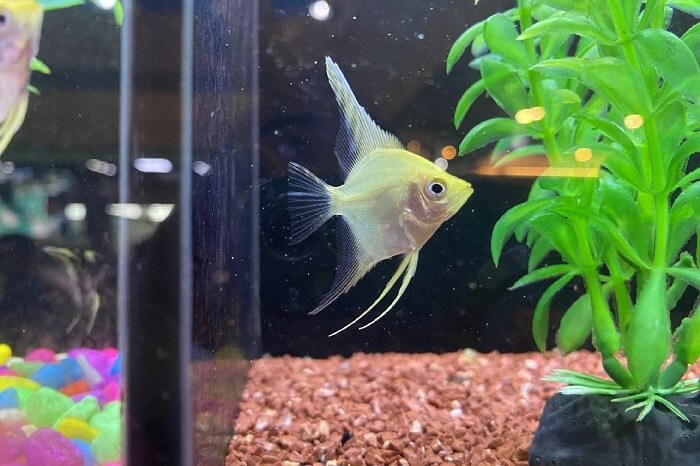
Also known as Pterophyllum, angelfish are freshwater creatures native to the Amazon Basin and other regions within South America. Angelfish colors are among the most pleasant out of all the breeds that aquarium enthusiasts favor. Their stripes add a welcomed trait, giving them a lot more flair.
Although they come in various colors, caring for angelfish doesn’t change according to their appearance. It’s pretty common for angelfish to change colors over time. However, this is particularly concerning if your angelfish suddenly begin to lose the vibrant, patterned colors you cherish.
Regarding the change in colors, there’s never really one main factor that causes this. Instead, it’s a compilation of different things that all correlate with the well-being of your fish. You’ll find that tank conditions, water parameters, tank hierarchy, and mating behaviors are all a part of what makes an angelfish fade over time.
As an aquarist, you must understand the fish you’re dealing with. This article will provide the necessary information to help you understand why your angelfish is losing color. We will also cover the proper steps to take if you want to see a safe recovery for the affected fish.
Angelfish Patterns Explained
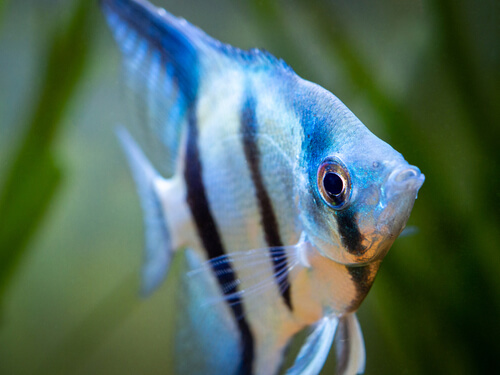
Like most other fish, angelfish are not immune to losing their colors. However, their signs of color loss are a bit more evident due to the patterns they have around their bodies. They usually have dark and vertically aligned stripes, almost like a zebra. There’s also a unique feature with angelfish, where these patterns can fade. This instantaneous change in looks can be due to fear or just a natural part of its behavior.
Your pet’s changed color due to stress can also be coupled with your angelfish not moving. You should react accordingly to these signs of distress.
The science behind this pattern change is their physiology. They have two important layers of fish skin in play, the dermis and the epidermis. Within the dermis is where the pigmentation lies. However, the pigmentation can fade according to the stress levels of your fish. When it is calm, the darker colors are more visible.
Meanwhile, a fish feeling stressed or threatened in its environment can appear quite faded. An angelfish turning black or white is a feature that naturally comes with their behavior and environment.
Why Do Angelfish Lose Color?
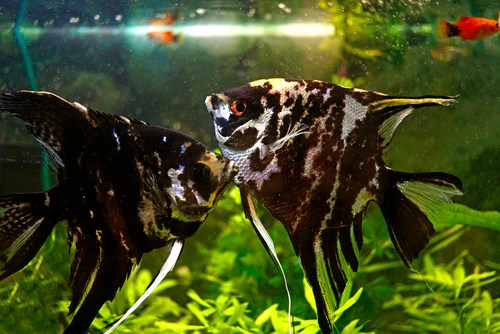
While they can begin to lose their vibrant colors due to stress and natural responses, there are some scenarios where the color changes can be more long-lasting. In such situations, you should know the triggers and what you can do to reverse those effects.
1. Sleeping
One of the more straightforward reasons for your angelfish losing color is that it may just be asleep. It’s not a big deal. Like other living organisms worldwide, angelfish need to regenerate their bodies after a full day of activities. In particular, if your angelfish have microtears on their body, sleep can help them repair their bodies.
Recovering from these microtears puts a fair bit of strain on your fish’s energy. The consequence is your angelfish losing color while it’s sleeping. This subtly implies that when your angelfish is awake, it actually uses energy to keep the pigment of its skin vibrant. The colorful look directly represents the identity of an angelfish among a sea of similar creatures.
It’s not always easy to spot a sleeping angelfish. They may have lively colors, but retaining that appearance requires a routine that involves getting a fair amount of rest. Still, an angelfish not moving should serve as a good indicator that it is getting some rest.
2. Stress
Stress is like a type of kryptonite for angelfish. Angelfish can experience high levels of stress due to many factors, and they are extremely susceptible to the dangerous consequences of it. In other words, the risk of losing your angelfish is possible if you leave it stressed for too long.
When an angelfish is stressed, the first sign is its stripes begin to fade almost immediately. Unfortunately, the stripes may also disappear entirely in the process. After the fading, other symptoms can manifest into your angelfish not moving. Dealing with these problems as they arise is something that isn’t going to be easy.
When your angelfish is losing color, it’s best to start checking for the reasons behind this problem. This could even involve other angelfish within your tank. Angelfish tend to have a hierarchy in play, especially when the tank size is inadequate for everyone to flourish.
If there is a hierarchy, you’ll notice that certain angelfish may seem pale compared to others due to the bullying. Additionally, pregnant angelfish are usually more susceptible to the impact of bullying within a tank. So you’ll want to keep them away from the other fish.
3. Illness And Diseases
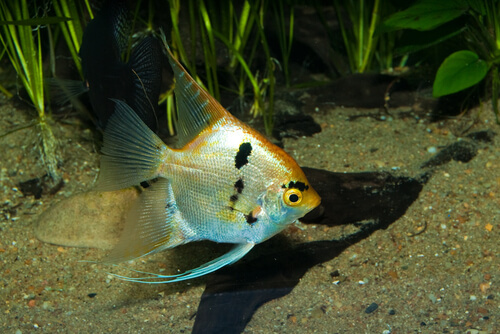
If an angelfish is suffering from the effects of an ailment, its stripes may begin to fade. However, watching this happen in real-time is something you may not immediately view as a big problem. This is because angelfish stripes disappear for pretty much any illness as a way to conserve energy. Therefore, it’s harder to tell how severe the sickness your angelfish is suffering from may be. Also, you may not be able to easily detect what type of illness they may have.
To spot specific illnesses, it’s best to closely observe your fish’s skin, watching for signs of white spots, bloating, or fraying on its fins. These symptoms are all related to some diseases commonly found in fish. For example, conditions like Ich, fin rot, and dropsy are usually accompanied by physical signs like these.
An angelfish dealing with these health issues is never something easy to experience. However, you can take a few steps to prevent some of the more dire consequences. For one, prepare a quarantine tank for your infected fish, separating them from the rest of their tank mates. While in quarantine, you can provide them with essential nutrients. Contact a marine vet as soon as possible to get an idea of what treatments you should use.
4. Environment
Your angelfish losing color and fading may be the consequence of its environment, not just the tank environment but the actual location. As sensitive creatures, angelfish tend to absorb light from the room where they are situated. Because they are so sensitive, there’s also a risk of startling them when the lights are turned on or off irregularly. If your tank is located in a part of your house that is often busy, you may immediately notice the worst of their behaviors.
For angelfish, improper lighting conditions can throw them off completely and can affect their overall health. Watching your angelfish turning black or white from bad lighting is something you can successfully address with a consistent light source in the tank.
In addition, avoid keeping your tank in a room where the light goes off and on a lot. Finally, ensure that the angelfish have access to warm lighting from an artificial source.
5. Water Conditions
If your tank has unsuitable water conditions, your angelfish may begin to suffer. Their stripes, in particular, may be affected, causing them to disappear for long periods. In addition, their overall appearance may start to become dull or faded. You’ll also notice your angelfish not moving when things get extremely bad.
You should aim to keep the pH levels in your tank at 6.0-8.0 and ensure that the water temperature is consistent with the needs of angelfish. These aquatic creatures usually thrive in temperatures of 78 to 84 degrees Fahrenheit.
When you notice that the stripes of your angelfish begin to fade after changing the water, this is a prime indication that the type of water in your tank isn’t ideal for them. In other words, it’s time to check your water parameters and monitor the conditions to avoid seeing your angelfish losing color.
Water conditions can have an immediate and lasting impact on the health of angelfish, so you should always treat it with care.
How To Restore Color To Your Angelfish
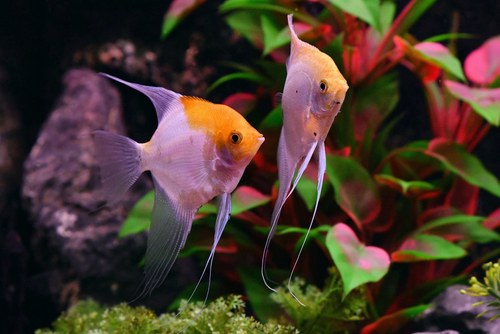
If your angelfish have lost their stripes or begun to fade, it’s time to see if there’s a way to reverse these effects. While it’s true that their stripes tend to return once they don’t feel threatened or sick anymore, the vibrancy is something that doesn’t always stay consistent.
1. Watch Out For Signs Of Stress
Angelfish are not perfect, and they are also not the toughest creatures that can be found in aquariums. If you want them to survive and thrive, you’ll need to constantly look for things that may be causing stress. An angelfish losing color is something that can be reversed with enough attention.
Angelfish go through occasional moods where they don’t want to interact with anything. To help them recover successfully, having a few pieces of shrubbery and rocks can be helpful. Create an environment in your tank where it is easy and convenient for the fish to hide if it ever feels insecure or threatened.
The type of tank mates you choose for your angelfish is also something to remember while caring for them. They are not the friendliest with other species, so if you introduce an aggressive fish to the tank, your angelfish can easily become stressed, and this could affect their health.
2. Control Overpopulation In Your Tank
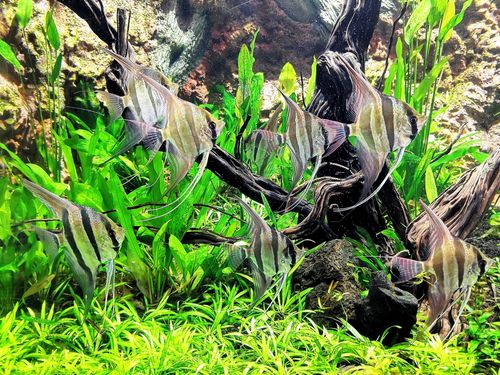
Overpopulation is another massive problem with angelfish tanks. If you want your fish population to stay safe and secure, it’s time to cut down on the number of fish. Keep the male-to-female ratio at a reasonable figure with at least 1 male to every 2 females.
With overpopulation, you’ll also encounter problems like tank pollution because of the constant waste. Dangerous minerals can quickly build up in your tank, such as ammonia, increasing the risks of your angelfish turning black or white and contracting an illness.
3. Provide A Rich Diet
Angelfish are omnivores and typically enjoy a varied diet with high protein. Feeding them bloodworms and brine shrimp should be enough to keep them healthy. In addition, proteins are quite helpful for angelfish, giving them a chance to retain vibrant colors and avoid permanently fading.
Bottom Line
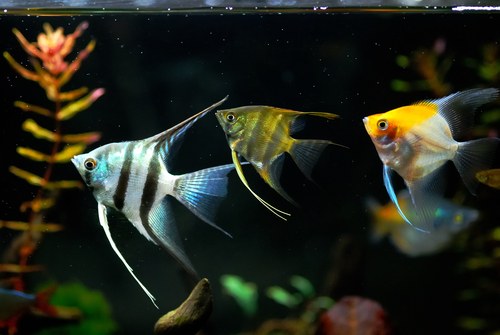
Angelfish losing color is something that you will encounter as a natural part of caring for them. However, if you want this occurrence to be less frequent, you’ll need to pay attention to their environments and create ways for them to comfortably deal with stress and avoid the consequences of discomfort. This guide provides everything you should know and will ensure that angelfish can thrive in your aquarium.



